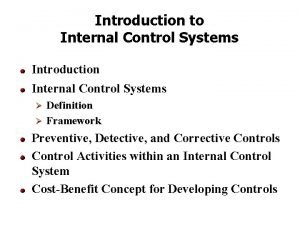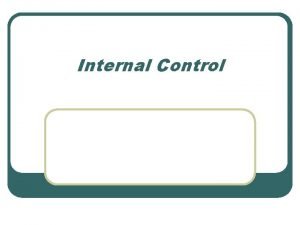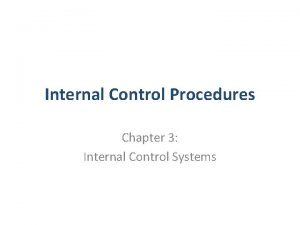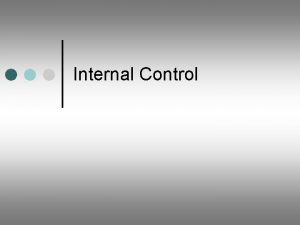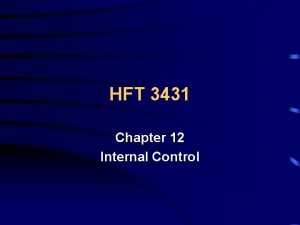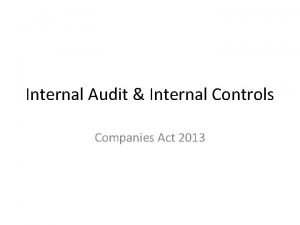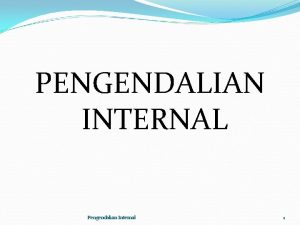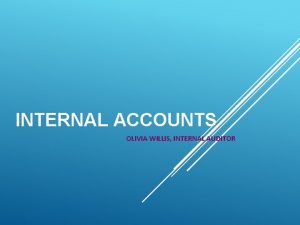Internal Control The Importance of Internal Control An














- Slides: 14

Internal Control

The Importance of Internal Control An appropriate internal control system functions to: • Ensure the integrity, relevance and reliability of information. • Safeguard the entity’s assets. • Detect and deter fraud and irregularities. • Maintain efficient and effective use of resources. • Ensure compliance with both management policies and external regulations.

Definition • Internal Control can be defined as: The process designed and effected by those charged with governance, management, and other personnel to provide reasonable assurance about the achievement of the entity’s objectives with regard to reliability of financial reporting, effectiveness and efficiency of operations and compliance with applicable laws and regulations.

Internal Control Policy To achieve these outcomes a business needs to have: 1. Control objectives Specific objectives of the organisation. 2. Standards or benchmarks Established criteria by which achievement or performance is measured. 3. Information flow to monitor standards or benchmarks The system that directs information from within the organisation to management as to whether required standards or benchmarks are being achieved. 4. Corrective action policy The action taken when standards or benchmarks are not met.

Management’s Responsibilities • Management is responsible for the provision of the internal control system in an organisation.

Internal Control Systems: Definition An internal control system covers all areas of management: • Accounting, financial and investing. • Strategic and operational planning. • Organisational change. • Asset control. • Business environment. • OH&S. • Management Information System. • Production/manufacturing. • Customer service. Internal Control Principles 6

The Elements of an Internal Control System include: • Plans. • Policies. • Procedures. • Information systems. • Organisational structures. • Training and professional development. • Codes of conduct. Internal Control Principles 7

The Risk Assessment Process • Identifying business risks • Estimating the significance of the risks • Assessing the likelihood of their occurrence; and • Deciding about actions to address those risks Internal Control Principles 8

The Information System The following areas are of particular importance to accurate financial reporting: • The procedures • The related accounting records and supporting information • How the information system captures events and conditions • The financial reporting process • Controls surrounding journal entries or adjustments. An effective accounting system should be designed to ensure: • Adherence to management policies and practices • Transactions are properly authorised and reviewed • Assets are safeguarded • Compliance with accounting standards and concepts • Reliable reporting and the effective allocation of resources Internal Control Principles 9

Control Activities Examples of specific control activities include those relating to: • Authorisation • Review of business performance • Information processing and IT controls • Physical controls • Segregation of duties Internal Control Principles 10

Monitoring of Controls Monitoring of controls is a process to assess the effectiveness of the internal control system and taking action to rectify any identified weaknesses and/or breaches of its controls. Internal Control Principles 11

Types of Internal Control Nature of controls: • Preventative — deter undesirable events from occurring. Examples: a locked door; fire drill; requirement of two signatures on cheques. • Detective — detect and sometimes correct occurrence of undesirable events. • Examples: smoke alarm; observe payroll distribution; oil light on car. • Directive — encourage or cause a desirable event. Examples: traffic lights; competitive wages; ongoing training. • Adaptive controls — controls that adjust to various situations in a changing environment. Examples: Sunglasses; thermostat; access password. • Corrective controls — correct problems identified by detective controls. Examples: fire extinguisher; transaction trail; suspense accounts for rejected items. Internal Control Principles 12

Areas of Control Accounting Controls – These are controls to ensure integrity and accuracy of financial reports and the provision of an accurate accounting information system. Operational Controls – Dictate the manner in which an organisation performs its activities and conducts its affairs. Compliance Controls – Focus on the business operations remaining within the boundaries of local, state and federal laws. Internal Control Principles 13

Types of Control • Physical Controls — controls that can be seen and touched that prevent an activity from occurring. – Examples: locked doors; off-site backup. • Manual Controls — performed by individuals not computers. – Examples: physical inventory counting; review of aged receivables. • IT Controls — focus on access and authorisation and the security of data as it flows through the information system. – Examples: check digits; encryption of messages; audit trails. Internal Control Principles 14
 What are the 7 principles of internal control
What are the 7 principles of internal control Features of vouching
Features of vouching Hát kết hợp bộ gõ cơ thể
Hát kết hợp bộ gõ cơ thể Lp html
Lp html Bổ thể
Bổ thể Tỉ lệ cơ thể trẻ em
Tỉ lệ cơ thể trẻ em Voi kéo gỗ như thế nào
Voi kéo gỗ như thế nào Tư thế worm breton
Tư thế worm breton Hát lên người ơi
Hát lên người ơi Môn thể thao bắt đầu bằng chữ đua
Môn thể thao bắt đầu bằng chữ đua Thế nào là hệ số cao nhất
Thế nào là hệ số cao nhất Các châu lục và đại dương trên thế giới
Các châu lục và đại dương trên thế giới Công thức tiính động năng
Công thức tiính động năng Trời xanh đây là của chúng ta thể thơ
Trời xanh đây là của chúng ta thể thơ Cách giải mật thư tọa độ
Cách giải mật thư tọa độ


















